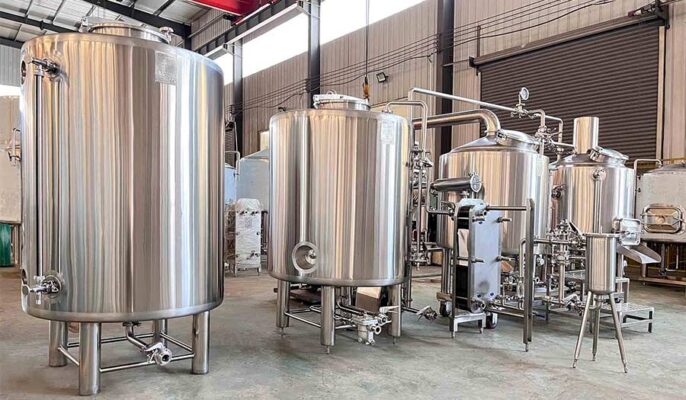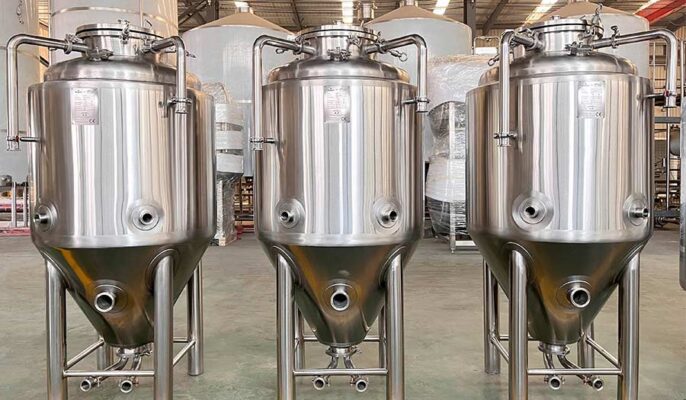나노 브루어리 구축은 양조업자의 궁극적인 목표입니다. 독특한 맛과 혁신적인 풍미를 추구하는 맥주 애호가들이 계속 증가함에 따라 나노 브루어리도 새로운 소규모 양조 모델로 부상하고 있습니다. 나노 브루어리는 일반적으로 연간 수천에서 수만 리터의 생산 능력을 갖춘 매우 작은 생산 규모의 양조장을 말합니다. 이 소규모 양조장의 장점은 유연성과 높은 공정 제어로 양조업체가 독특한 레시피와 풍미를 개발하는 데 집중하면서 현지화된 맞춤형 맥주 제품을 제공할 수 있다는 것입니다. 이 글에서는 나노 양조장을 구축하는 방법과 비용을 소개합니다.
나노 양조장이란 무엇인가요?
용어에서 짐작할 수 있듯이 나노 양조장은 소규모 양조장보다 규모가 작고 연간 맥주 생산량이 훨씬 적습니다. 나노 브루어리의 간단한 정의는 연간 15,000배럴 미만의 맥주를 생산하는 양조장 또는 브루펍입니다. 나노 양조장의 연간 생산량 한도는 다른 양조장과 같은 방식으로 정의되지 않습니다. 소규모 양조장과 달리 소규모 양조장과 나노 양조장을 구분할 수 있는 명확한 배럴 수는 없습니다. 일반적으로 나노 양조장은 소규모로 운영되며 일반적으로 개인 소유로 운영됩니다.
나노 양조장의 특징:
- 소규모 생산: 나노 브루어리는 일반적으로 연간 수천 리터에서 수만 리터에 이르는 소규모 생산 규모를 가지고 있습니다. 이러한 소규모 생산 모델을 통해 양조장은 생산 계획을 보다 유연하게 조정하고 시장 변화와 소비자 수요에 신속하게 대응할 수 있습니다.
- 높은 맞춤화: 나노 양조장은 생산 규모가 작기 때문에 각 맥주에 집중하여 고도로 맞춤화된 맥주를 제공할 수 있습니다.
- 현지 운영: 나노브루어리는 현지 시장에서 운영하기로 결정하고 주변 지역 사회와 현지 소비자에게 서비스를 제공하기 위해 최선을 다하고 있습니다.
- 혁신적인 개발: 나노 양조장의 유연성은 혁신에 큰 이점을 제공하며, 양조자는 다양한 양조 레시피를 시도할 수 있습니다.

나노 양조장과 소규모 양조장의 차이점은 무엇인가요?
- 규모 차이: 나노 양조장에 필요한 장비는 일반적으로 수백 리터 용량의 양조 포트와 발효 탱크와 같이 더 작고 컴팩트한 장비입니다. 소규모 양조장은 더 많은 생산량을 지원하기 위해 수천 리터에서 만 리터 이상의 양조 시스템과 같은 더 큰 규모의 장비가 필요합니다.
- 자동화 수준: 나노 양조장은 수동 작업과 기본 장비 사용을 선호할 수 있으며 장비 자동화 수준이 낮습니다. 이와 대조적으로 소규모 양조장은 종종 더 높은 수준의 자동화 장비자동화된 양조 제어 시스템과 효율적인 세척, 충전 및 포장 장비 등 생산 효율성과 일관성을 개선하기 위한 장비가 있습니다.
- 기능 및 구성: 나노 양조장의 장비에는 수동 양조의 요구를 충족하는 기본 기능이 장착되어 있을 수 있습니다. 소규모 양조장의 장비에는 다기능 양조 시스템, 자동 온도 제어 및 발효 관리, 보다 효율적인 필터링 및 포장 장비와 같은 보다 복잡한 기능이 필요합니다.
- 비용과 투자: 나노 양조장의 장비 투자는 일반적으로 소규모이며, 장비 제조업체는 비교적 저렴한 가격으로 맞춤형 소형 장비 키트를 제공할 수 있습니다. 소규모 양조장에는 더 큰 규모의 장비가 필요하며, 장비 제조업체는 더 많은 투자가 필요한 시스템을 제공해야 하고 추가적인 기술 지원 및 유지보수 서비스가 필요할 수 있습니다.
설정하는 방법 나노 양조장?
사업 계획 결정
나노 양조장을 설립하기 전에 먼저 세부적인 사업 계획을 수립해야 합니다. 여기에는 시장 조사, 목표 고객 그룹, 경쟁 분석 및 재무 예측이 포함됩니다. 목표 시장의 요구와 트렌드를 이해하면 매력적인 제품을 설계하는 데 도움이 됩니다.
적합한 위치 선택
적절한 위치를 선택하는 것이 성공의 열쇠입니다. 나노 양조장은 일반적으로 비교적 작은 공간이 필요하므로 생산 요구 사항을 충족할 수 있고 교통 시설이 잘 갖춰진 장소를 선택하는 것이 중요합니다.
필요한 허가 취득
양조장을 설립하려면 생산 허가, 보건 허가, 판매 허가 등 다양한 허가 및 라이선스를 신청해야 합니다. 향후 법적 문제가 발생하지 않도록 현지 규정과 요건을 준수해야 합니다.
생산 프로세스 설계
원료 조달, 양조, 발효, 포장 등 세부적인 생산 공정을 개발합니다. 나노 양조장은 일반적으로 제품 품질을 보장하기 위해 섬세한 공정에 의존합니다. 올바른 장비를 선택하고 합리적인 생산 공정을 설계하는 것이 핵심입니다.

장비 및 원자재 구매
나노브루어리에는 고품질의 양조 장비와 원료가 필요합니다. 신뢰할 수 있는 공급업체를 선택하고 장비와 원자재가 생산 요건을 충족하는지 확인하세요. 장비에는 일반적으로 양조 포트가 포함됩니다, 발효 탱크, 여과 시스템 및 병입 장비.
양조 시스템: 양조 시스템은 양조장의 핵심이며, 여러분의 필요에 맞는 시스템을 선택하는 것이 중요합니다. 기본 양조 시스템에는 맥즙 배럴, 라우터 툰, 양조 주전자가 포함되어야 합니다. 양조 기능을 향상시키기 위해 뜨거운 맥주 탱크, 월풀 또는 리턴 탱크와 같은 기능을 추가할 수도 있습니다.
- 발효 탱크: 맥즙이 양조되면 맥주를 생산하기 위해 발효를 거쳐야 합니다. 발효 탱크는 개방형 및 폐쇄형 발효기, 단일 탱크, 투명 탱크 등 다양한 크기와 스타일로 제공됩니다. 양조장에 적합한 크기와 온도 제어 및 압력 방출 밸브와 같은 필요한 기능을 갖춘 발효 탱크를 선택하는 것이 중요합니다.
- 밝은 탱크: 맥주가 발효되면 정화 및 탄산을 위해 투명 탱크로 옮겨집니다. 투명 탱크는 발효기와 비슷하지만 다른 용도로 설계되었습니다. 발효기와 마찬가지로 투명 탱크도 다양한 크기와 스타일로 제공됩니다.
- 냉각 및 온도 제어 시스템: 맥주 양조에는 온도 제어가 매우 중요하며, 양조 및 발효 과정 내내 적절한 온도를 유지할 수 있는 시스템을 갖추는 것이 중요합니다. 냉각 시스템에는 냉각수 순환을 위한 냉각기, 열교환기, 펌프가 포함될 수 있습니다.
- 품질 관리 및 세척 장비: 성공적인 양조장 운영을 위해서는 고품질 표준을 유지하는 것이 필수적이며, 이를 위해서는 pH 측정기, 용존 산소 측정기, 분광광도계와 같은 품질 관리 장비가 필요합니다. 브러시, 호스, 세척 약품 등 청소 장비도 중요합니다.
직원 채용 및 교육
맥주 생산에는 숙련된 직원을 채용하는 것이 필수적입니다. 직원들은 양조 과정을 이해하고 장비를 효과적으로 작동할 수 있도록 관련 교육을 받아야 합니다.
브랜드 구축 및 마케팅
강력한 브랜드 이미지와 마케팅을 구축하는 것이 고객 유치의 핵심입니다. 고유한 브랜드 로고를 디자인하고 소셜 미디어 홍보, 맥주 전시회 참가, 지역 이벤트 진행 등 마케팅 전략을 개발하세요.
생산 모니터링 및 최적화
생산 공정과 제품 품질을 정기적으로 모니터링하고 생산 공정을 적시에 조정하여 효율성과 제품 품질을 개선합니다. 피드백과 데이터 분석을 통해 생산 프로세스를 지속적으로 최적화합니다.
판매 채널 구축
현지 바, 레스토랑, 슈퍼마켓, 온라인 판매 플랫폼 등 다양한 판매 채널을 구축하세요. 유통업체 및 소매업체와 좋은 협력 관계를 구축하면 시장 범위를 넓히는 데 도움이 됩니다.
법적 및 안전 기준 유지
공장 운영이 식품 안전과 직원 안전을 포함한 모든 안전 및 법적 기준을 충족하는지 확인합니다. 이는 직원을 보호할 뿐만 아니라 브랜드 평판과 소비자 신뢰도 향상에도 도움이 됩니다.
나노 양조장 장비는 어떻게 선택하나요?
양조 요구 사항 평가
예상 생산량에 따라 적합한 나노 양조 장비를 선택하세요. 나노 양조장에는 일반적으로 소형 장비가 필요하므로 너무 크지도 작지도 않은, 양조장의 생산 요구 사항을 충족할 수 있는 시스템을 선택하는 것이 중요합니다. 목표 생산량과 향후 성장 계획을 고려하여 양조장에 적합한 용량을 결정하세요.
장비 재료 선택
양조 시스템의 재료는 맥주의 품질과 장비의 수명 모두에 중요한 역할을 합니다. 스테인리스 스틸은 내구성이 뛰어나고 부식에 강하며 세척이 쉽기 때문에 가장 일반적인 선택입니다. 스테인리스 스틸은 304와 316 등 다양한 등급이 있으며, 그 중 316은 부식에 강해 장기간 사용하기에 더 좋습니다.
난방 방법
양조 시스템에는 직화, 전기, 증기 등 세 가지 주요 가열 방법이 사용됩니다. 각 방법에는 장단점이 있으며, 양조장에 가장 적합한 방법은 예산, 사용 가능한 유틸리티, 공간 제약 등의 요인에 따라 달라집니다. 각 옵션을 조사하고 특정 상황에 따라 장단점을 비교해 보세요. 확실하지 않은 경우 미케트 그룹에 문의할 수도 있습니다.
비용 및 예산
배송, 설치 및 시운전 비용을 포함한 장비의 초기 구매 비용을 고려하세요. 장비의 총 비용이 예산에 맞는지 확인합니다. 일상적인 유지보수, 부품 교체 및 수리 서비스를 포함하여 장비의 유지보수 및 운영 비용을 파악하세요. 유지 관리가 쉽고 수리 비용이 합리적인 장비를 선택하면 장기적인 운영 비용을 줄일 수 있습니다.
공간 요구 사항
선택할 때 나노 양조 시스템를 참조하여 양조장의 사용 가능한 공간을 고려하세요. 선택한 시스템이 시설 내에 편안하게 설치되는 동시에 적절한 환기, 작업 흐름, 유지 관리 및 청소가 용이한지 확인해야 합니다. 또한 시간이 지남에 따라 양조장이 확장될 수 있으므로 향후 확장에 대한 계획을 세우는 것도 중요합니다.
자주 묻는 질문
나노 양조장이란 무엇인가요?
나노 양조장은 일반적으로 연간 생산량이 수천에서 수만 리터에 이르는 소규모 맥주 생산 시설입니다. 이들은 수제 양조, 고도로 맞춤화되고 현지화된 시장에 초점을 맞춰 소비자에게 독특하고 개인화된 맥주 제품을 제공합니다.
나노 양조장을 설립하려면 어떤 초기 준비가 필요하나요?
- 시장 조사: 목표 시장의 니즈, 경쟁사, 소비자 선호도를 파악합니다.
- 사업 계획: 생산 규모, 재정 예산, 마케팅 전략을 포함한 세부 사업 계획을 수립합니다.
- 사이트 선택: 현지 규정과 비즈니스 요구 사항을 준수하면서 생산 및 유통에 편리한 위치를 선택합니다.
나노 양조장을 설립하려면 어떤 라이선스가 필요하나요?
- 생산 라이선스: 맥주 제조 및 판매를 허용하는 공식 라이선스입니다.
- 위생 허가: 생산 환경이 건강 및 안전 기준을 충족하는지 확인합니다.
- 판매 라이선스: 주류 판매 라이선스: 주류 판매를 허용하는 라이선스입니다.
- 환경 라이선스(해당되는 경우): 환경 규정을 준수하는지 확인합니다.
장비를 선택할 때 고려해야 할 요소는 무엇인가요?
- 생산 능력: 예상 생산량에 적합한 장비를 선택합니다.
- 장비 구성: 양조 포트, 발효 탱크, 여과 시스템, 포장 장비의 기능 및 사양을 포함합니다.
- 품질과 내구성: 장비의 수명을 연장하기 위해 좋은 재료와 제조 품질로 만들어졌는지 확인합니다.
- 예산: 장비 구매, 운송, 설치 및 유지보수 비용이 포함됩니다.
- 기술 지원: 우수한 애프터서비스 및 기술 지원을 제공하는 공급업체를 선택하세요.




